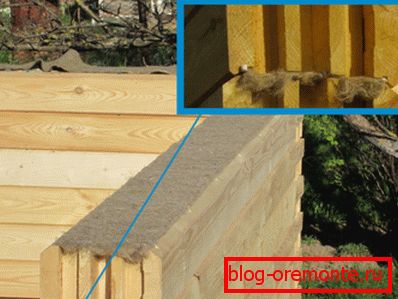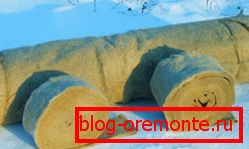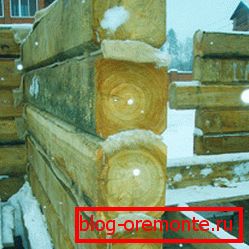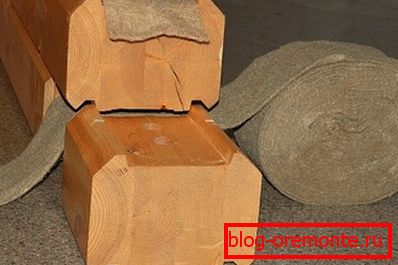Mezhventsovy heater for timber: an excellent material for
In nature, there are several basic types of insulation for houses made of logs and lumber, which are distinguished by the quality of thermal insulation and special technical characteristics. These include mezhventsovy insulation for timber, which is popular because it is able to very high quality and reliably retain the heat of a wooden residential house.
Today, similar material from jute is considered one of the most advanced types of protection and heat preservation in timber structures. It may consist of jute nonwoven fabric, flax jute, flax cotton and ribbon tow. Jute is a derivative of jute fiber, which is supplied to the Russian Federation from Bangladesh and India.

Material Features
Varieties
- Lnovatin is a non-woven product and consists of 100% flax.
- Flax jute - usually consists of 15-20% flax + 80-85% jute. In this case, the percentage may well be somewhat changed.
- Linen ribbon tow as the first version consists of 100% flax - it is used mainly as insulation between the bar (logs - for intervening seams), and also has wide use as a caulk of wooden buildings, embedding joints between logs and joinery (doors , window). The usual width of tape tow is 150 mm and the thickness is 8-10 mm.

What to choose
Most private developers and construction companies, as a heater for the walls of the bar in the inter-timber joints use the option of flax jute and jute. Lnovatin is more often used by developers of an individual character who purchase material on the construction markets in full confidence that they buy exactly jute insulation.
Often, the consumer is faced with the question of what kind of material to choose? Jute, tow or lnovatin? Which one is better and better?

Definitely answer these questions is not so easy, but let's try.
Choosing the mezhventsovy insulation for a log house first of all you need to know:
- about the quality of the made log;
- about the quality of the mating grooves and felled cups in a bar or logs.
As a rule, the component parts of a rounded log of a log house or wooden house have a lower groove of a higher quality, unlike log log cabins chopped with an ax. In addition, the walls of log houses are often planed (profiled) or sawn with a rather coarse treatment of wall bars.

Because mezhventsovy insulation material for timber and for log cabins made of rounded logs, most suitable in the form of a ribbon of flax or nonwoven jute canvas. But for chopped log houses more suitable tow tape from flax and jute.
Distinctive characteristics
There is no particular difference between inter-linen insulants made of flax and jute. Both of these materials are great for both insulating the seams of houses from a bar, and for assembly. However, there is one feature in these products, on which we want to focus your attention, it is density.
Tip! The tighter the mezhventsovy insulation for laminated veneer lumber, the better the joint will be insulated. That is why this parameter is very important! In some cases, the density indicator is more important than the thickness of the material - after all, dense insulation is much better than thick, less dense.

Modern builders especially appreciate the manufacturability in the use of tape heaters, the use of which significantly speeds up installation work, and also contributes to a uniform distribution over the entire surface of the intervenence space.
Comparative characteristics of jute insulation
Let's conduct a comparative analysis of diverse tape heaters, for which we consider the "lush" and "thin" jute material:
- "Lush" insulation for a bar of jute appeared on the markets not so long ago. The material attracts attention with its thickness, besides attracts insignificant price. However, it is worth considering - the external "pomp" can conceal the low density of the surface (as we said above).
Such cheap jute is made by joining jute fibers by the method of gluing - called chemical heat bonding. Fibers are combined with each other under the influence of elevated temperature, while using synthetic materials (mainly polyester).

With this method, you can observe the following:
- the consumption of raw materials is reduced by several times, which reduces the cost;
- The manufacturing process is more fleeting.
- Insulation for the house of the bar "thin" - is made using needle-punching technology: the fibers are attached using long jute fibers that pull short ones. This technology is more labor-intensive and expensive, but it significantly increases the quality of the material, its uniformity over the entire surface of the insulation.
This event leads to the following:
- such insulation does not exfoliate at all;
- it does not accumulate moisture (breathes);
- does not release harmful chemicals destroying timber.
You should know! Dense thin material is easy to drill while equipping the holes needed for the nog.

Required calculation
What should be considered when buying, so as not to purchase "air"? There is a specific instruction. First of all, the surface density of the interlayer insulation is taken into account.
It depends on the following indicators:
- length;
- width;
- weight.
The width and length you will know when you buy, the weight is easily determined by weighing. After this, the parameters already known are entered into the calculation formula:
The surface density is directly proportional to weight (g) and inversely proportional to length and width (m). The resulting value is compared with the specified manufacturer (seller).
Example:
- with a thickness of 5 mm - the density of the surface will be 400 g / sq m;
- with a thickness of 8-10 mm - density close to 600 g / sq m;
- at 15 mm - an approximate density of 800 g / sq m.
Tip! You should not save money when buying insulation, because the inter-ring joint is a particularly “weakened” part of wooden structures.
Technological process of laying
Lay insulating material in the crowns, as a rule, in three ways.
They depend on the thickness of the layers of different rolls:

- Jute in one layer;
- Insulation in half;
- Folding from the edges.
Laying on glued timber
Jute insulation is purchased with a width equal to the bar-shaped (if the beam is 150x150 mm - jute is taken 150 mm + - 20 mm), with a thickness of 6-8 mm. (See also the article Glulam: features.)
For the chopped type log house, jute felt of a wider format is used, with a thickness of 10-15 mm. Excess width at the same time, as a rule, is bent and caulked.

Finally
Warming of houses from a bar is a very necessary and important process, especially for areas where winters are cold and long. As you have seen, mezhventsovy insulation material is easy to choose. In the presented video in this article you will find additional information on this topic.